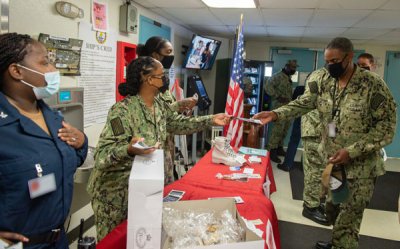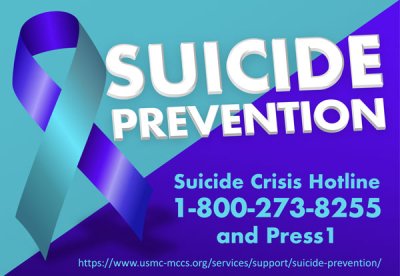‘People Feel Expendable’—Military Could Lower Suicide Rate With Focus on Quality of Life
Active-duty service members and veterans thinking of harming themselves can get free crisis care. Contact the Military Crisis Line at 988, then press 1, or access online chat by texting 838255.
In the summer of 2022, Craig Bryan, a psychologist, listened as a young service member explained why some days life didn’t seem worth living. The man in his early 20s didn’t point to combat-related trauma or the burden of physical injury. He felt depleted from his job in finance, specifically processing reimbursements for his fellow service members.
As Bryan recalls, the young man with dark hair, a thin frame, and a cautious way of speaking recounted how the software used by the Defense Department often resulted in errors or long delays. As a result, service members would come to his desk to yell about their lack of payment, and when he tried to correct the problems, the software would cause his computer to crash. Rebooting took 20 minutes, and it was not uncommon for the upset individual to complain to the man’s supervisor, who would later shout at him for poor performance.
The service member often stayed up working until midnight (only to oversleep for morning exercise, which resulted in more reprimanding) and said that when he thought about his future, he drifted into hopelessness.

Psychologist Craig Bryan speaks to a room of David Grant USAF Medical Center mental health care providers at Travis Air Force Base, California, in 2022. Bryan, a leading national expert on military suicide, taught advanced skills training for the providers during a two-day session. Photo by Lan Kim, courtesy of the U.S. Air Force.
“What’s the point of any of this?” Bryan recalls him saying. That triggered alarms in Bryan’s head. “When I heard that I was like, Holy shit, this kid’s at risk for suicide.”
Bryan didn’t think work stress alone might result in suicide. But the young service member appeared depressed. If he were to break up with a partner or lose a loved one, that would only push him closer toward risk. Easy access to a gun would multiply the risk further.
Another concern: his age. About half of military suicides on Defense Department property involve people 25 years old or younger.
This young man was one of nearly 3,000 individuals across nine military installations interviewed for a report released earlier this year by the Suicide Prevention and Response Independent Review Committee, which formed at the direction of Congress under Secretary of Defense Lloyd Austin in the spring of 2022.
Bryan, who deployed to Iraq in 2009 as a psychologist in the Air Force and is a professor of psychiatry and behavioral health at The Ohio State University, was one of 10 committee members who developed a 115-page report listing dozens of recommendations to improve service member well-being and reduce the persistent suicide problem. Since the 2001 launch of the war on terror, suicide rates have roughly doubled in the military.
After several months of talking with service members, their families, mental health providers, and others, Bryan started to view active-duty suicide as “death by a thousand paper cuts,” he says.
Those “paper cuts” range from a chronic shortage of behavioral health providers to a lack of computers for service members who must complete online training, delays in paychecks and reimbursements, and no air conditioning in sweltering barracks—complaints Bryan and his colleagues heard repeatedly.
“There were just barriers to, I would say, to successful living,” says Rebecca K. Blais, a psychologist who served on the committee and says she was “struck” by the volume of daily stressors. Eliminating some of them, the committee argues, could help the mental state of service members, making them more resilient to whatever active duty throws at them. And while adding computers and improving housing may sound like an easy lift—especially considering the Defense Department’s $1.77 trillion budget—those familiar with how the military bureaucracy operates aren’t hopeful this report will result in significant, lasting change.

Graphic by Keith Pannell, courtesy of the U.S. Army.
“We know a lot about the problem—we know what we need to do,” says M. David Rudd, a psychology professor at the University of Memphis who has researched military suicide for more than three decades. “I think the probability is it won’t be done.”
Rudd blames the military mindset. The Defense Department should overhaul what defines “military readiness,” he says, calling it the most critical step in suicide prevention. Rather than evaluating command staff based on their training schedules, physical fitness scores, and marksmanship performance, he says, there should also be accountability for the mental fitness of the people in their units.
“Everybody views that as not related to military readiness,” he says, adding that military culture should shift to a more comprehensive view on military readiness that includes the toll of daily stressors, such as struggling to buy groceries. (A 2018 RAND Corporation report found that roughly 26% of active-duty service members are food insecure.) “If somebody can’t get paid, that impairs military readiness. You just don’t have people who think that way. That’s just not the way commanders think.”
And, many of the findings in the SPRIRC report aren’t new, Rudd says. Over the last 15 years, several reports across the services have detailed ways the Defense Department could tackle suicide—but the findings have so far failed to spark deep, sustained action.
“If the recommendations that have been repeatedly raised by multiple groups are not implemented, there is little reason to expect that suicides among military personnel will drop,” the SPRIRC report reads.
A plan to implement many of the SPRIRC’s recommendations is past the June due date set by Austin, but a Defense Department spokesperson says it’s coming.
‘Not Everyone Who Dies by Suicide Has a Mental Health Condition’
Prior to the Sept. 11, 2001, attacks, civilian suicide rates were far higher than those in the miltary when comparing age groups. That flipped about five years into the wars in Iraq and Afghanistan, Rudd says. In 2021, a “Costs of War” research paper out of Brown University estimated nearly 32,000 active-duty personnel and veterans of the post-9/11 wars died by suicide—significantly more than the 7,057 service members killed during combat in that same time frame.

Military officials recommend reaching out to people who may be having difficulties and then helping them get to resources, such as the suicide helpline, if they are at risk for suicide. Photo illustration by Joshua J. Seybert, courtesy of the U.S. Air Force.
Despite millions of dollars of DOD research on the topic, the problem lingers. In the first quarter of 2023, the Army recorded 49 suicides, compared to 37 in the same time frame in 2022—according to the DOD’s most recent quarterly suicide report. The Marine Corps also reported an increase.
Outside military installations, suicide in America has surged in the last two decades, particularly among teens and young adults. The demand for mental and behavioral health services far outpaces available providers, a challenge that the military and Veterans Affairs face, as well.
At many installations, service members have to wait four to six weeks between psychotherapy sessions, reducing treatment efficacy and prolonging symptoms, according to the SPRIRC committee. The report lists ways to remedy this—many of which have been issued in the past—including expediting hiring and eliminating budget and statutory limitations that hinder the Defense Department’s ability to increase pay.
But Blais says it’s important to recognize suicide as a complex tangle of factors.

Capt. Anthony Priest, behavior health officer with 1st Signal Brigade, speaks with Company B, 304th Expeditionary Signal Battalion-Enhanced, in South Korea in 2022, about suicide. Photo courtesy of the U.S. Army.
“I think one of the conceptions that people often have is that people who die by suicide have a diagnosable mental health condition,” she says. “And that’s certainly not the case.”
Mental health can falter when everyday problems compound, and that can also trigger verbal abuse between service members and their families, Blais says.
“Military service members are trained to survive anything and with the fewest amount of resources possible,” she says. “That is part of what they need to be able to do. But what we were seeing on installations is that they were doing that day to day when it wasn’t required.”
When three junior sailors killed themselves in April 2022 while serving on the same aircraft carrier, investigators found daily stress contributed. They were assigned to the USS George Washington, a ship that was in a years-long “midlife overhaul” at Huntington Ingalls Industries-Newport News Shipbuilding in Virginia. A Navy investigation released in May found that thousands of sailors who have worked and lived on the ship since 2017 endured a poor quality of life, despite more than two dozen complaints to the inspector general between 2020 and 2022 addressing uninhabitable living conditions, safety violations, mistreatment of sailors on the basis of gender and sexual orientation, and the mishandling of sexual assault allegations.
Award-Winning Journalism in Your Inbox
While no direct correlation was found among the deaths of the three sailors, the report details the unpleasantness of daily life. Without enough parking at the shipyard, for instance, sailors often parked miles away and endured an up to two-hour commute by bus in traffic jams—a slog that drained morale.
Living quarters for the hundreds of sailors lodging on the ship were often without WiFi or reliable cell phone service—lifelines in modern society. The parents of one of the deceased soldiers told NPR that their son often tried to sleep in his car, or he would occasionally break rules and drive eight hours to visit home, only to return to the ship sleep-deprived and weary.
‘It Makes People Feel Expendable’
Programs that boost morale, improve mental health and decrease suicide rates do exist. The Defense Department’s own research has identified several effective therapies that help prevent suicide. But, “there’s no plan to roll them out” and embed them as staples of the Military Health System, Bryan says.
The Army’s Holistic Health and Fitness program shows promise. Early data reflects a 37% reduction in suicides between 2019 and 2022 in units that have implemented it, according to an article in Army Times. But the SPRIRC committee found it’s not unusual for such successes to operate in a silo or, when leadership changes within units, the program to fade away.
More than a decade ago, a task force with the same charge as SPRIRC—which issued many of the same recommendations—highlighted the need for a “positive command climate” and leadership that’s held accountable for the entire well-being of service members, not just the physical aspect of health.

U.S. Navy sailors assigned to the aircraft carrier USS John C. Stennis distribute pamphlets to raise awareness for suicide prevention on the floating accommodation facility, in Newport News, Virginia, in 2021. Photo by Mass Communication Specialist 2nd Class Thomas Pittman, courtesy of the U.S. Navy.
Blais, the psychologist, says there’s evidence of a recent change in how leaders are selected in the Army. The Battalion Command Assessment Program focuses not only on physical and cognitive requirements for effective leadership, but also integrates assessment of written and verbal communication skills, feedback from peers and subordinates, and results of interviews with psychologists. She’d like to see all branches adopt that model, she says. As it is now, the promotion system rewards people who’ve been in the military a long time and may be good at the mission side of the armed forces, but not necessarily at the leadership required to keep service members healthy.
“One of the things that we heard, for example, is we would ask commanders, ‘How do you address your service members when someone dies by suicide?’” she says. “And it’s like, ‘Well, we don’t talk about it. We don’t want to draw attention to it.’ And it wasn’t malicious, but they’re just like, ‘If we tell people it’s going to happen, then it’s going to happen more.’ And as a psychologist, it’s like, ‘No, that makes people feel like they’re expendable and that they don’t matter.’”
‘We’re Not Saying People Shouldn’t Have Guns’
While there were nearly two dozen recommendations ranked as top priority, only a handful related to limiting access to guns drew heated debate online, including one that proposed prohibiting the sale of guns and ammunition to troops younger than 25 years old on Defense Department property.
When The New York Post reported on the proposal, readers derided a “woke” military and the violation of the Second Amendment.
Defense Department data indicates about 66% of active-duty suicides, 72% of reserve suicides, and 78% of National Guard suicides involve firearms. Citing a policy change that required Israeli military personnel to store their military-issued weapons in armories over the weekend and how that led to a 40% reduction in the Israeli military’s suicide rate, SPRIRC offered policy proposals that also attempt to limit access to personal guns.
When she helped to craft recommendations, Blais reviewed data that indicated it was not uncommon for men between the ages of 18 to 24 to have recently gone through a breakup, gotten drunk, and then tried to kill themselves.
If that gun is harder to reach for? “At the worst, they would have a really bad hangover the next day,” Blais says. “We’re not saying that people shouldn’t have guns. We’re just saying that we might want to be more thoughtful about where guns are and where they’re located and who has access to them and where.”

Graphic by David Smith, courtesy of the U.S. Marine Corps.
Rudd likens the controversy to seat belts. Though the initial requirement of seatbelts ignited rally cries of lost freedom, eventually the federal government realized the safety benefits were too great to ignore. Since suicides are often hard to predict, he says, “steps to improve safety have a positive impact, just like seatbelts.”
The report also recommends screening for excessive alcohol use and displaying alcohol less prominently in military exchanges.
In March, the Defense Department announced a few of the SPRIRC’s recommendations would be adopted immediately as a task force worked through a more permanent, thorough plan. Those recommendations included expediting the hiring of behavioral health providers, screening for excessive alcohol use during primary care appointments, and improving scheduling of behavioral health appointments.
In April, the Defense Health Agency began a pilot program that allows service members to book several behavioral health appointments at once—rather than having to schedule a follow-up after each visit—with the hope that the program will expand across the Military Health System, a Defense Department spokesperson tells The War Horse.
In an emailed statement, Sen. Kirsten Gillibrand, a Democrat from New York who serves on the Armed Services committee, says she expects the Defense Department to take this report “seriously.” She’s pushed the military for years to ease career stressors and strengthen mental health services.
Our Journalism Depends on Your Support
“I will be watching for real progress,” she says.
Bryan is watching too.
Though it’s been months since he sat in a conference room listening to that young, stressed-out service member, he finds himself thinking about him often.
He remembers the young man looked crumpled, exhausted—like someone under so much pressure, with such minimal relief, that he couldn’t picture his future as anything but grim.
“He is an exemplar of how institutional factors and quality of life matters are so important for understanding the emergence of suicidal thinking and suicidal behavior,” Bryan says.
This War Horse investigation was reported by Anne Marshall-Chalmers, edited by Kelly Kennedy, fact-checked by Jasper Lo, and copy-edited by Mitchell Hansen-Dewar. Headlines are by Abbie Bennett.





Comments are closed.